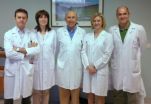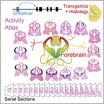(Press-News.org) Afforestation, planting trees in an area where there have previously been no trees, can reduce the effect of climate change by cooling temperate regions finds a study in BioMed Central's open access journal Carbon Balance and Management. Afforestation would lead to cooler and wetter summers by the end of this century.
Without check climate change is projected to lead to summer droughts and winter floods across Europe. Using REMO, the regional climate model of the Max Planck Institute for Meteorology, researchers tested what would happen to climate change in 100 years if land currently covered in non-forest vegetation was converted into deciduous forest. This equates to more than a doubling of forest in Poland, Czech Republic, Denmark, Northern Ukraine, Northern Germany and France. But in already heavily forested countries such as Sweden the increase is smaller, at less than 10%.
The large leaf area and low aerodynamic resistance of these types of trees lends itself to enhanced evapotranspiration compared to other vegetation, cooling the surrounding air, and leading to cooler surface temperatures. The model indicates that in the northern part of central Europe and Ukraine afforestation results in 0.3-0.5C decrease in temperature and 10-15% more summer rain by 2071-2090.
The effect of planting trees depends on the environment of each region. Dr Borbála Gálos, who led this study, explained, "While we realize that the amount of afforestation included in our model is unrealistic in practice, even a more modest program of planting trees could theoretically reduce the effect of climate change in Northern Europe. There is less of an effect in more southerly regions due to complex issues including soil moisture content. However, even in these areas, forest cover can provide localized benefits by making the surrounding air moister and cooler, sequestering carbon, protecting biodiversity and air quality, and preventing soil erosion."
INFORMATION:
Media contact
Dr Hilary Glover
Scientific Press Officer, BioMed Central
Tel: +44 (0) 20 3192 2370
Mob: +44 (0) 778 698 1967
Email: hilary.glover@biomedcentral.com
Notes
1. Case study for the assessment of the biogeophysical effects of a potential afforestation in Europe
Borbála Gálos, Stefan Hagemann, Andreas Hänsler, Georg Kindermann, Diana Rechid, Kevin Sieck, Claas Teichmann and Daniela Jacob
Carbon Balance and Management
This article is the first article of an ongoing series into European afforestation and its impact on the climate benefits of European forests.
Please name the journal in any story you write. If you are writing for the web, please link to the article. All articles are available free of charge, according to BioMed Central's open access policy.
Article citation and URL available on request on the day of publication.
2. Carbon Balance and Management is an open access, peer-reviewed online journal that encompasses all aspects of research aimed at developing a comprehensive policy relevant to the understanding of the global carbon cycle. @CBMjournal
3. BioMed Central (http://www.biomedcentral.com/) is an STM (Science, Technology and Medicine) publisher which has pioneered the open access publishing model. All peer-reviewed research articles published by BioMed Central are made immediately and freely accessible online, and are licensed to allow redistribution and reuse. BioMed Central is part of Springer Science+Business Media, a leading global publisher in the STM sector. @BioMedCentral
Planting trees may not reverse climate change but it will help locally
2013-02-01
ELSE PRESS RELEASES FROM THIS DATE:
New stroke gene discovery could lead to tailored treatments
2013-02-01
An international study led by King's College London has identified a new genetic variant associated with stroke. By exploring the genetic variants linked with blood clotting – a process that can lead to a stroke – scientists have discovered a gene which is associated with large vessel and cardioembolic stroke but has no connection to small vessel stroke.
Published in the journal Annals of Neurology, the study provides a potential new target for treatment and highlights genetic differences between different types of stroke, demonstrating the need for tailored treatments. ...
Discovery in synthetic biology takes us a step closer to new 'industrial revolution'
2013-02-01
The scientists, from Imperial College London, say their research brings them another step closer to a new kind of industrial revolution, where parts for these biological factories could be mass-produced. These factories have a wealth of applications including better drug delivery treatments for patients, enhancements in the way that minerals are mined from deep underground and advances in the production of biofuels.
Professor Paul Freemont, Co- Director of the Centre for Synthetic Biology and Innovation at Imperial College London and principle co-investigator of the study, ...
The genome of rock pigeon reveals the origin of pigeons and the molecular traits
2013-02-01
January 31, 2013, Shenzhen, China – In a study published today in Science, researchers from University of Utah, BGI, and other institutes have completed the genome sequencing of rock pigeon, Columba livia, among the most common and varied bird species on Earth. The work reveals the evolutionary secrets of pigeons and opens a new way for researchers to study the genetic traits controlling pigeons' splendid diversity. The findings also help to fill the genetic gaps in exploiting pigeon as a model for the molecular genetic basis of avian variation.
People are quite familiar ...
Placental blood flow can influence malaria during pregnancy
2013-02-01
Malaria in pregnancy causes a range of adverse effects, including abortions, stillbirths, premature delivery and low infant birth weight. Many of these effects are thought to derive from a placental inflammatory response resulting from interaction of infected red blood cells with the placental tissue. In a study published in the latest issue of the journal PLOS Pathogen*, a researchers' team led by Carlos Penha-Gonçalves at the Instituto Gulbenkian de Ciência (IGC), Portugal, observed, for the first time, the mouse placental circulation and showed how it can influence the ...
Sequencing hundreds of chloroplast genomes now possible
2013-02-01
Researchers at the University of Florida and Oberlin College have developed a sequencing method that will allow potentially hundreds of plant chloroplast genomes to be sequenced at once, facilitating studies of molecular biology and evolution in plants.
The chloroplast is the compartment within the plant cell that is responsible for photosynthesis and hence provides all of the sugar that a plant needs to grow and survive. The chloroplast is unusual in containing its own DNA genome, separate from the larger and dominant genome that is located in every cell's nucleus. ...
Examining the so-called Basque mutation of Parkinson's
2013-02-01
This press release is available in Spanish.
The relationship between genetics and Parkinson's has been investigated for more than a decade, but it is only over the last few years that significant results have begun to be obtained. The first mutations related to the development of this disease were found in 2004. A team from the UPV/EHU-University of the Basque Country came across a mutation of the LRRK2 gene, which is particularly prevalent among the population of Gipuzkoa. It is the R1441G mutation and is known as the Basque mutation. Now, Doctor Javier Ruiz, a doctor ...
NASA sees a coronal mass ejection erupt from the sun
2013-02-01
On Jan. 31, 2013 at 2:09am EST, the sun erupted with an Earth-directed coronal mass ejection or CME. Experimental NASA research models, based on observations from the Solar Terrestrial Relations Observatory (STEREO) and ESA/NASA's Solar and Heliospheric Observatory, show that the CME left the sun at speeds of around 575 miles per second, which is a fairly typical speed for CMEs. Historically, CMEs at this speed are mild.
Not to be confused with a solar flare, a CME is a solar phenomenon that can send solar particles into space and reach Earth one to three days later.
Earth-directed ...
The effective collective: Grouping could ensure animals find their way in a changing environment
2013-02-01
For social animals such as schooling fish, the loss of their numbers to human activity could eventually threaten entire populations, according to a finding that such animals rely heavily on grouping to effectively navigate their environment.
Princeton University researchers report in the journal Science that collective intelligence is vital to certain animals' ability to evaluate and respond to their environment. Conducted on fish, the research demonstrated that small groups and individuals become disoriented in complex, changing environments. However, as group size is ...
Evidence of geological 'facelift' in the Appalachians
2013-02-01
How does a mountain range maintain its youthful, rugged appearance after 200 million years without tectonic activity? Try a geological facelift – courtesy of the earth's mantle.
Researchers from North Carolina State University noticed that a portion of the Appalachian Mountains in western North Carolina near the Cullasaja River basin was topographically quite different from its surroundings. They found two distinct landscapes in the basin: an upper portion with gentle, rounded hills, where the average distance from valley to mountain top was about 500 feet; and a lower ...
Genome-wide atlas of gene enhancers in the brain online
2013-02-01
Future research into the underlying causes of neurological disorders such as autism, epilepsy and schizophrenia, should greatly benefit from a first-of-its-kind atlas of gene-enhancers in the cerebrum (telencephalon). This new atlas, developed by a team led by researchers with the U.S. Department of Energy (DOE)'s Lawrence Berkeley National Laboratory (Berkeley Lab) is a publicly accessible Web-based collection of data that identifies and locates thousands of gene-regulating elements in a region of the brain that is of critical importance for cognition, motor functions ...





